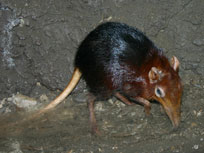Macroscelidea -- betwixt an elephant and a shrew



Origins
Macroscelidea stands for macro = 'long' and skelidos = 'legs'. One wonders if the naming committee noticed this creature's long, glorious nose. As noses go, these group of animals can literally mime a play with this awesome appendage. Just to clear the air a bit, this group is not related to shrews. We are dealing with a very old group of mammals whose ancestry is so complicated that taxonomists are heard to curse softly when this delightful group is mentioned in passing. We do know that this order is related to elephants,aardvarks and hyraxes based on the latest DNA analysis.
Physical Characteristics
Elephant shrews are small animals with brownish gray coats. Thye vary in size from about 10 to almost 30 centimeters, and from just under 50 g to over 500 g. All are four-legged with mouse-like tails, and rather long legs for their size which are used to hop and jump about like rabbits. Although the size of the trunk varies from one species to another, all are able to twist it about in search of food. Their life span is about two and a half to four years in the wild. They have large canine teeth, and also high-crowned cheek teeth like those of grass eaters. Although mostly active during early morning and at dusk(diurnial), they are difficult to trap and very rarely seen: elephant shrews are wary, well camouflaged, and adept at dashing away from threats. Several species make a series of cleared pathways through the undergrowth and spend their day patrolling them for insect life: if disturbed, the pathway provides an obstacle-free escape route.
Geographic Distribution
View Larger Map
They are widely distributed across the southern part of Africa, and although common nowhere, can be found in almost any type of habitat, from the Namib Desert to boulder-strewn outcrops in South Africa to thick forest. One species, the North African Elephant Shrew, remains in the semi-arid, mountainous country in the far north-west of the continent.
Reproduction
Females give birth to litters of one or three young several times a year, after a gestation period varying from 45 to 60 days. The young are born relatively well developed, but remain in the nest for several days before venturing outside. The mating period lasts for several days and is followed by six weeks of gestation. After mating, the pair will return to their solitary habits. The female then will give birth to 1-2 young in one of her leaf nests. Only for nursing purposes are the young visited by the mother. After 5 days the young are fed mashed insects with the milk, which are collected and transported in the cheek pouches of the female. The young then slowly start to explore their environment and start to hunt for insects. After about 15 days, the young will begin the migratory phase of their life which lessens the dependency of the young on their mother. The young will then establish their own home ranges (about 1 km2) and go about their own jumping ways.
Feeding Habits
All elephant-shrews eat mainly insects, spiders, centipedes, millipedes, and earthworms. An elephant-shrew uses its nose to find prey and uses its tongue to flick small food into its mouth, much like an anteater. Eating large prey can pose somewhat of a challenge for the elephant shrew. For example, a giant elephant-shrew struggling with an earthworm must first pin its prey to the ground with a forefoot. Then, turning its head to one side, it chews pieces off with its cheek teeth, much like a dog chewing a bone. This is a sloppy process, and many small pieces of worm drop to the ground; these are simply flicked up with the tongue. Some elephant-shrews also feed on small amounts of plant matter when available, especially new leaves, seeds, and small fruits.
Videos
Species within Macroscelididae
Genus Elephantulus
Short-snouted Elephant Shrew -- Elephantulus brachyrhynchus
Cape Elephant Shrew -- Elephantulus edwardii
Dusky-footed Elephant Shrew -- Elephantulus fuscipes
Dusky Elephant Shrew -- Elephantulus fuscus
Bushveld Elephant Shrew -- Elephantulus intufi
Eastern Rock Elephant Shrew -- Elephantulus myurus
Somali Elephant Shrew -- Elephantulus revoili
North African Elephant Shrew -- Elephantulus rozeti
Rufous Elephant Shrew -- Elephantulus rufescens
Western Rock Elephant Shrew -- Elephantulus rupestris
Genus Macroscelides
Short-eared Elephant Shrew -- Macroscelides proboscideus
Genus Petrodromus
Four-toed Elephant Shrew -- Petrodromus tetradactylus
Genus Rhynchocyon
Golden-rumped Elephant Shrew -- Rhynchocyon chrysopygus
Checkered Elephant Shrew -- Rhynchocyon cirnei
Black and Rufous Elephant Shrew -- Rhynchocyon petersi
Grey-faced Sengi -- Rhynchocyon udzungwensis